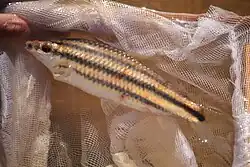Brevidens
| Brevidens | |
|---|---|

| |
| Scientific classification | |
| Kingdom: | Animalia |
| Phylum: | Chordata |
| Class: | Actinopterygii |
| Order: | Characiformes |
| Family: | Anostomidae |
| Subfamily: | Leporininae |
| Genus: | Birindelli, Sidlauskas & Melo, 2025 |
| Species: | B. striatus
|
| Binomial name | |
| Brevidens striatus (Kner, 1858)
| |
| Synonyms[2] | |
| |
Brevidens is a monospecific genus of freshwater ray-finned fish belonging to the family Anostomidae, the toothed headstanders. The only species in this genus is Brevidens striatus, a fish found in tropical South America.
Taxonomy
Brevidens was first proposed as a monospecific genus in 2025 by the Brazilian ichthyologists José Luís O. Birindelli, Brian L. Sidlauskas and Bruno F. Melo with Leporinus striatus as its only species.[3] Leporinus striatus was first formally described in 1858 by Rudolf Kner with its type locality given as Irisanga and Caicara in Mato Grosso, Brazil.[2] This species was originally classified in the genus Leporinus but Birindelli, Sidlauskas and Melo found that this taxon was paraphyletic and, among other taxonomic changes, reclassified L. striatus in the new genus Brevidens.[4] Brevidens is classified in the subfamily Leporininae of the family Anostomidae, the headstanders, in the suborder Characoidei of the order Characiformes.[5]
Etymology
Brevidens means "short tooth", an allusion to the short fourth tooth on the dentary, a diagnostic character of this genus. The specific name, striatus, means "striped", a reference to the longitudinal dark and pale stripes along the body of adults of this species.[6]
Description
Brevidens has a maximum total length of 25 cm (9.8 in).[7] This taxon is distinguishable from other genera in this family in having a very small fourth tooth on the lower mandible, which has a clear gap between it and the other teeth. It also has a distinctive pattern of four horizontal black stripes along the body. Other features of this genus include 3 premaxillary teeth, in adults the mouth is subterminal with a red spot on the upper lip and there are 16 rows of scales around the caudal peduncle.[4] The body is fusiform and low, with a staright profile at the origin of the anal fin.[8]
Distribution and habitat
Brevidens is widespread throughout much tropical South America south to Argentina. It is a benthopelagic fish which is migratory within river systems found in fast-flowing water, being commoner in small tributaries than in the main channels.[1]
Biology
Brevidens is a diurnal, omnivorous fish with its diet being made up of plat matter, insects and molluscs. This species spawns throughout the year and undertakes short migrations to spawn, depositing eggs and not showing any parental care.[8]
References
- ^ a b Frederico, R.G.; Reis, R. & Lima, F. (2022). "Leporinus striatus". IUCN Red List of Threatened Species. 2022: e.T167629A53819878. doi:10.2305/IUCN.UK.2022-2.RLTS.T167629A53819878.en. Retrieved 23 July 2025.
- ^ a b Eschmeyer, William N.; Fricke, Ron & van der Laan, Richard (eds.). "Species in the genus Brevidens". Catalog of Fishes. California Academy of Sciences. Retrieved 23 July 2025.
- ^ Eschmeyer, William N.; Fricke, Ron & van der Laan, Richard (eds.). "Genera in the family Leporininae". Catalog of Fishes. California Academy of Sciences. Retrieved 23 July 2025.
- ^ a b Sidlauskas, Brian; Melo, Bruno; Birindelli, Jose; et al. (2025). "Molecular phylogenetics, a new classification, and a new genus of the Neotropical fish family Anostomidae (Teleostei: Characiformes)". Neotropical Ichthyology. 23. doi:10.1590/1982-0224-2024-0076.
- ^ "Eschmeyer's Catalog of Fishes Classification". Eschmeyer's Catalog of Fishes. California Academy of Sciences. Retrieved 23 July 2025.
- ^ Christopher Scharpf (4 May 2025). "Family ANOSTOMIDAE Günther 1864 (Toothed Headstanders)". The ETYFish Project Fish Name Etymology Database. Christopher Scharpf. Retrieved 23 July 2025.
- ^ Froese, Rainer; Pauly, Daniel (eds.). "Leporinus striatus". FishBase. April 2025 version.
- ^ a b Lima, Talita Rolim de Freitas & Smith, Welber Senteio (2024). "Aspects of the ecology of Leporinus striatus Kner 1858 as a support for its conservation in a Federal Conservation Unit". Acta Scientiarum Biological Sciences. 46 (1) e69946. doi:10.4025/actascibiolsci.v46i1.69946.
